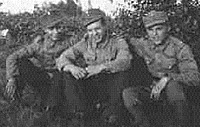As the Russians began to recover from the beating they had taken in 1941, they began to conduct limited counterattacks in the north. On New Year's Day 1942, they launched an attack on Finnish II Corps (once more reorganized, and now composed of 4 and 8 Divisions plus both Jager Brigades) north of Povenets. The Russian 32 Army attacked with six rifle divisions, three naval rifle brigades and a ski brigade, but they were beaten off without any significant shifting of the lines.
 Finnish soldiers during 1942.
Finnish soldiers during 1942.
On 11 April the Soviets launched another army-sized attack on the Svir River front, (7 Army, with five rifle divisions and three naval infantry brigades) followed two weeks later by a corps attack (three rifle divisions, a naval rifle brigade, and a ski brigade) in the Kestenga area, then defended by Group J and the German 6 SS Mountain Division (Battle Group Nord had been earlier withdrawn to Germany and upgraded to a full division). The fighting, though fierce, was inconclusive.
In the first half of 1942, there was a certain amount of reorganization along the front. In the north, AOK Norwegen was renamed 20 Mountain Army in June and General Edward Dietl (one of the few competent generals who was in consistently good odor with Adolf Hitler, due to his Nazi loyalties) as its commander. The Gebirgskorps was renamed XIX Mountain Corps, and 3 Mountain Division was replaced by 6 Mountain Division; the Finnish 6 Division was withdrawn from XXXVI Corps, and the German 163 Division was shifted up from the Svir River front to replace it; and XVIII Mountain Corps was formed in the Kestenga area to control 7 Mountain Division and 6 SS Mountain Division. The Finnish III Corps was withdrawn to the south.
In the south, the Karelian Army was disbanded and the Finnish Army was reorganized into three front commands:
- Karelian Isthmus: 2, 10, 15, 18 Divisions;
Svir River: 5, 7, 11, 17 Divisions; and
Maaselkae Isthmus (north end of Lake Onega): 1, 4, 8 Divisions and 3, 12 Brigades (formed respectively from 12 and 6 Divisions, which had been disbanded)
Mannerheim also set about forming an armored division at Petrozavodsk from the hundreds of T-26 and BT-5/7 tanks that had been captured from the Soviets in the Winter War and the summer offensive.
The high point of Axis military activity in the north for 1942 was to be Operation Lachsfang (Salmon Catch), a simultaneous attack by German and Finnish forces respectively in the Kandalaksha and Belomorsk areas, with the objective of cutting the Murmansk Railway line where it really counted. If this operation were a success (and it is reasonable to expect that one of the two attacks could have broken through) it would have a great impact on the Red Army's operations, since they were already reeling from the German offensive towards Stalingrad and the Caucasus.
However, Mannerheim declared that Finland would not be able to do its part in this operation until the Germans had secured Leningrad and advanced Army Group North to the Svir, thus allowing him to release sufficient troops from these fronts. Finnish troops also would not be able to help in the city's capture, for the same reasons that held them back in 1941 (not only that - the Finnish government had received a not-so-veiled threat from the United States that they would declare war on Finland if it made any decisive attacks on the Murmansk Railway).
At first, the Germans agreed to this conditions and started to prepare Operation Nordlicht ("Northern Lights"), an assault on the city with large amounts of aircraft and siege artillery sent up from Sevastopol, but the unrelenting pressure of the Soviet attacks along the Volkhov front south of Lake Ladoga forced them to use the assault troops to defend the existing battle front. By September-October the situation had stabilized but by then the summer was over and it was too late to attack Leningrad. "Salmon Catch" was shelved for 1942, and never was carried out.
More Finland Continuation War 1941-45
- Introduction
1941: Co-Belligerence in the North
1941: The Karelian Army Advances
1942: Motion Is Not Progress
1943: The Turn of an Unfriendly Card
1944 - The End of the Continuation War
Conclusion
Expatriate Soldiers
Mannerheim: Marshal of Finland
Finland: Jumbo Map of Operations
Back to Cry Havoc #30 Table of Contents
Back to Cry Havoc List of Issues
Back to MagWeb Master Magazine List
© Copyright 2000 by David W. Tschanz.
This article appears in MagWeb (Magazine Web) on the Internet World Wide Web. Other military history articles and gaming articles are available at http://www.magweb.com